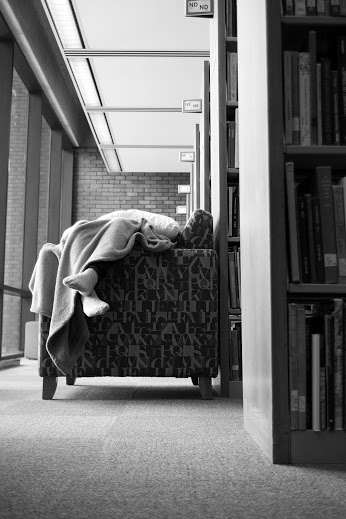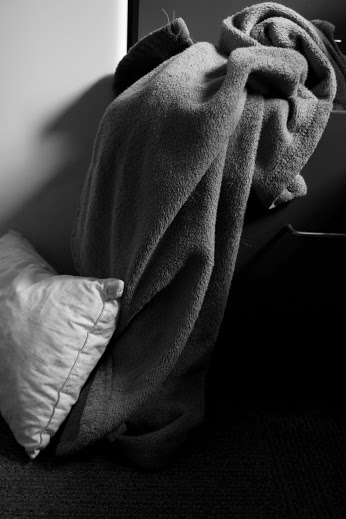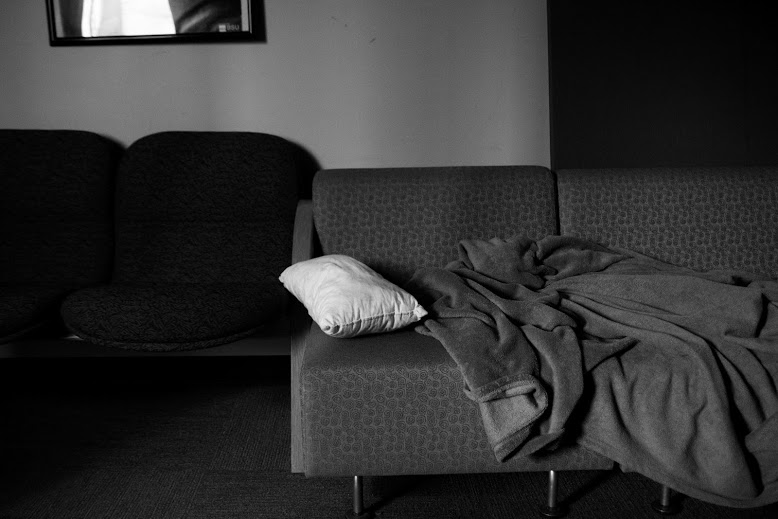This is the one of the stories published in Ball Bearings Magazine Spring 2016 edition. You can read the entire coverage here.
An estimated 58,000 college students are homeless throughout the country. Alicia Herder was one of them.
First one sweater, then another, then a third. She buttoned her black coat atop them before lying on the stiff, narrow couch. A nearby filing cabinet held the blanket and pillow she kept safe. Wrapping the blanket around her, and placing the pillow beneath her head, she grabbed what little sleep she could before waking that cold December morning as the campus lay resting.
She got up and walked briskly to the public restroom where she brushed her teeth, put in her contacts, and layered on makeup before returning to the study room she had slept in the night before. There she changed her clothes and secured her now folded blanket and pillow in the filing cabinet once again.
Then she made the long walk to her Toyota Corolla parked behind Ball State University’s David Letterman Communication and Media Building to put away her clothes and grab her backpack before heading off to class. Just a month earlier, Alicia Herder had parked that same car at the two-story house she shared with six roommates.
It was that November of 2013 when she realized she didn’t have enough money to pay both rent and food. She made what she called an “easy choice” between the two, because while she knew she couldn’t survive without food, she could survive without shelter. “I’m going to move out,” she told her roommates, without mentioning how she didn’t have a new home awaiting her. They didn’t seem to understand why she had to move out halfway through the school year, but they also didn’t know how little money Alicia had in the bank.
She was out of loans and out of options.
Leaving Comfort
Alicia packed away the inflatable mattress that had been lying on the floor of her bedroom. She rolled up the posters that had been hanging on her walls. Her movies, birthday cards, kitchen utensils, and many, many books, were placed into boxes for her mom to take. She’s never owned much, so there were only enough boxes to fill the trunk of a Toyota. The only thing she left behind was the desk she had inherited from a friend.
And then it was official. Alicia was without a home.
Just like the other 58,000 college students estimated in the U.S., according to the 2013 FAFSA application. Students who are sleeping in their cars, on the streets, on friend’s couches. Students who are, simply, homeless.
Those numbers are greatly underreported, said Cyekeia Lee, director of higher education initiatives at the National Association for the Education of Homeless Children and Youth (NAYCE). There may be more students out there, but officials wouldn’t know because these students don’t identify themselves as homeless. The shame, the embarrassment, the fear of unknown consequences can hold students back from checking that box.
Regardless, one truth remains: a striking number of college students are balancing studies, jobs, and preparation for future careers without knowing where they can safely catch a full night of sleep or find their next meal.
As the president of telecommunications club Cardinal Filmworks, Alicia had access to the Student Advisory Council Room (SAC) that student organizations used to meet during the day. A room in the Letterman building just big enough for two couches, a small desk, and a few chairs within its beige walls.
But at night, it was where Alicia sought refuge.
The hallways typically filled with echoing voices fell silent in the nighttime. The unnatural emptiness of night loomed, enhanced by gaping classrooms and void hallways. Vending machines flashed their blue buttons, attracting only ghosts to their stock. And within the SAC room, Alicia tried desperately to get her five precious hours of sleep behind the locked door to which only a select few had keycard access.
Homeless college students typically look like everyone else their age: clothed in yoga pants or warm sweaters or basketball shorts. They blend in, and they go unnoticed.
“I’ve been working with homeless students for a long time, over a decade, and I still have to kinda train my brain to think differently of what homelessness means or what even a homeless person looks like,” Cyekeia said.
And she would know, since she runs the hotline NAYCE provides for students to call with questions about being homeless. She’s spoken to students living in barns in Texas. She’s had students sleeping in ditches, bathing in creeks. One football player slept beneath the benches.
One student in New York scooped coins out of wishing wells just to have money to eat.
“I feel like I’m stealing people’s wishes every day,” he told her.
“I always hear about new places and I’m baffled that this is America and this is where we have college students sleeping,” Cyekeia said.
At Ball State University, administrators have learned of two instances of students living in their cars or staying in the library in the past 10 years. “Once we became aware, we helped them find fina ncial assistance to live temporarily in housing until a permanent solution was found,” Associate Vice President of Strategic Communications Joan Todd wrote in an email. “Most people who are homeless don’t want others to know, and go to great lengths to hide the fact.”
ncial assistance to live temporarily in housing until a permanent solution was found,” Associate Vice President of Strategic Communications Joan Todd wrote in an email. “Most people who are homeless don’t want others to know, and go to great lengths to hide the fact.”
From 2009 to 2011, 51.8 percent of students living off-campus and not with relatives had incomes below the poverty level, according to the U.S. Census Bureau. Low-income students will often live off-campus, forgo textbooks, and work long hours to pay the bills. Some students may choose to take a semester off to save money so they can later return to school.
But for those who don’t want to sacrifice a semester, or who have sacrificed all they can, one option remains: to continue their studies without the certainty of a roof over their head.
“I’m not going to pretend that I know of all the circumstances where a student has experienced homelessness. It’s probably not that often, but more often than we’d like to think,” said Dr. Michael Gillilan, director of student rights and community standards.
Dr. Gillilan said he’s not aware of any efforts within the university to quantify the extent of homelessness among its students. Colleges and universities aren’t required to keep track of how many of their students are homeless.
“At the K-12 level, all of the schools have a dedicated homeless liaison. They have much more of a closer relationship with their students and know what’s going on,” said Karen McCarthy, a senior policy analyst from the National Association of Student Financial Aid Administrators (NASFAA).
“Once the students get out of the K-12 level and move into the higher education stage, there isn’t a dedicated person at the higher education level who documents their homelessness. It gets a little less precise.”
Nationally, not much support or research exists for homeless college students. The 2015 State of Homelessness in America report said that unaccompanied youth and children accounted for 7.8 percent of the total homeless population.
If passed, The Higher Education Access and Success for Homeless and Foster Youth Act of 2015 will simplify the FAFSA to better categorize homelessness and will classify homeless or unaccompanied youth under 24 as independents, making it easier for these students to receive financial aid.
Adapting to New Circumstances
Alicia would often hang out in Bracken Library until its closing at 3 a.m. As she exited the library with friends, she’d make up excuses to cover why she wasn’t returning to a home like them. “Oh, I’ll study more in Letterman and stay up.”
She worried about leaving her blanket and pillow behind at first, but then realized people would only be bewildered by their presence. It wouldn’t cross their minds to suspect a homeless student was staying there.
As a double major in theater and telecommunications, Alicia didn’t want to take a semester off and fall behind. To do that would be to admit failure. She would feel even further away from her goal of going to grad school and becoming a film director.
She wasn’t willing to stop fighting for what she wanted, especially since she didn’t take college for granted in the first place. She had built up a resilience from her days in high school, when her parents told her they couldn’t support her financially if she chose to pursue college.
But she pursued it anyway, earning scholarships, working a part-time job at Greek’s Pizzeria, and taking out loans to pay the rest.
“I made my way into college,” Alicia said. “I was going to make sure I made my way out of college. It was going to be on my terms and my terms alone.”
Her Toyota Corolla was filled with winter clothing, her Greek’s Pizzeria uniform, and a few nice dresses just in case of special occasions. Her laptop, too. Little torn, crumpled notes filled a plastic baggie, remnants of times in high school when her friends would gather together to share handwritten compliments. Words of advice encouraging her to pursue her dream of filmmaking filled a letter from a friend at Stanford trying to achieve the same. These, for when she needed a “pick me up.”
If she didn’t need it to survive, she didn’t have it.
Like other students, Alicia chose to get by with less than she needed. Some students can’t receive help from their parents to get them through school. A 2013 College Board analysis found that for full-time undergraduate students, parents and students covered 38 percent of the total charges from funds other than grants or loans. But when parents like Alicia’s can’t afford to help their children through college, the burden falls on the student.
Even with Alicia’s connections with friends, and ability to get food, Linda, Alicia’s mom, worried for her daughter’s safety.
“Anything could happen. You don’t have a home base,” Linda said.
The unexpected did happen. There were nights when she was startled awake by the sound of a door opening. A janitor had stopped by the room to clean it up, only to apologize after realizing someone was sleeping there. “I don’t care,” Alicia said. The janitor left immediately without waiting to pick up trash or sweep the floors, and Alicia did the same, not returning until later so they had time to clean up before she fell asleep again.
“We probably scared each other just as much,” she said. It was an awkward situation, one she didn’t know how to navigate. She knew of no schedule for custodial work, so she paced out when she’d arrive. She didn’t want to interfere with their jobs, but she also didn’t want to get in trouble.
She was found by janitors about three times that semester, and the fear of getting in trouble never abated. None of the janitors ever said anything as far as Alicia knows, but Ball State custodians said it’s part of their jobs to note anything that’s suspicious or unsafe for students.
If custodians found someone who was homeless on campus, they could report them to their supervisor. Then, their supervisor can contact other offices or the police, as needed.
Secret Circumstances
Alicia didn’t know who had the authority to tell her to stop sleeping in the room, but she worried it would take one wrong word to the wrong person.
“It felt like if a lot of people found out what I was doing then maybe I could get in trouble,” Alicia said. “It felt like the more secretive I could make it, the safer my circumstances would be.”
If a student is experiencing homelessness, or any other kind of distress, administrators want to make sure they are getting the help they need, Dr. Gillilan said.
So it’s not uncommon for the Office of Student Affairs to get referrals from outside organizations about students “in distress” – meaning students hurting emotionally or mentally, students struggling with other life circumstances, or even students who are homeless.
But not all students open up about their struggles. And for those students, there’s no easy way to find out where to go for help. No specific department is charged with handling cases of homelessness.
The Office of Institutional Effectiveness doesn’t track the number of homeless students here. Dr. Gillilan hesitated, pondering where students should first seek help. Probably the dean or associate dean in the Office of Student Affairs, he said.
Emergency funding for students in distress is available from the university foundation through the Parent’s Fund. University guidelines restrict Ball State officials from giving students money directly, but they can pay a third party, such as a landlord or utilities company.
It’s been done in the past, like the student Dr. Gillilan remembered who couldn’t put down a housing deposit until his financial aid check cleared. The foundation paid his housing deposit, allowing him time to pay his rent later with money he received from financial aid.
“If we aren’t the right place to go, our commitment is that the next place you go will be the right place to be,” he said.
Sometimes, Dr. Gillilan said, that doesn’t mean it comes from the university. Ball State has connections with other local organizations, food pantries, and homeless shelters. Students can use a food pantry provided by Ball State’s Student Government Association each week.
But in order for students to receive these resources, they must know about them first.
“I’ll be honest, I’m by no means an expert on homelessness among college students and I’m not sure if there’s anyone around here who is,” Dr. Gillilan said. “I don’t think it’s something we understand all that well. In part because it’s very different in university circumstances.”
Overcoming Barriers
Some mornings she’d be up at 6 a.m. to get a shower in at the recreation center, which was rough because she hated mornings.
Among the lockers was one that housed her supplies: shampoo, conditioner, soap, a razor, her towel. When she’d shower in the morning, Alicia sometimes wouldn’t have time to return to her car to put her clothing away, so she’d stuff her items in her purse and carry on her day. She learned the exact way to roll up the bulkiness of her clothes so they fit just right. When she rifled through her purse to find a particular assignment, she took care so she wouldn’t accidentally pull out a pair of underwear, or some other piece of clothing.
Alicia’s weekdays were spent running between classes, clubs, and work, and squeezing in time to work on projects in between. Being homeless made her work harder in school because she was on campus constantly. She began the semester with a 3.8 GPA and maintained it throughout.
But it also became overbearing. Alicia began asking herself how many weeks in the semester were left. She was determined to leave Indiana, so she was constantly working on internship applications.
“If I’m not working my ass off right now do I really want to go to film school then? Do I really want to reach this goal? I don’t know what I would have done if I didn’t have a bigger goal like that,” Alicia said. “The best answer is [I would have] dropped  out. It completely sucked, but it was a reason to get up in the morning.”
out. It completely sucked, but it was a reason to get up in the morning.”
She didn’t want other people to worry about her. If she knew about them worrying over her, it would just add to the stress she didn’t need.
She made the most of her laundry, managing to last until spring break, when she stayed at a friends place and cleaned her clothes. There were a few other times she made use of a friend’s washer and dryer.
“It was like going to war everyday,” she said.
Her days in the trenches were numbered, but that didn’t mean she could stop fighting.
Most of the money she made waiting tables at Greek’s Pizzeria was saved with hopes that it would help her during an internship. She would set aside the rest for meals and whatever amount of coffee she could survive on. If she couldn’t pay for a home, she couldn’t justify spending money on anything fun. Her social life was less lively than before, and her sex life nonexistent. So she did what she could for free. Sometimes she’d rent a movie from the library, or go on a drive to the reservoir.
The feeling of absolute boredom enwrapped her like an endless cloud of fog.
Regardless of the day, there were too many people around, all the time. She could never escape them, or the stress of school. She never got a moment to herself, even when she was the only one in the room. There was no kitchen to cook a homemade dinner in. There was no Netflix to turn on. There was no escape.
She drove to the one place where she could seek true solitude: Prairie Creek Reservoir. Alicia stood on the frozen ground, staring out at the wrinkles of frozen water. The crisp air chipped into her skin. No sound existed aside from the air brushing across the reservoir, like wind chimes whispering. She could finally escape the constant chatter of classes, the footsteps resounding on sidewalks, the internal apprehension of what came next. Here it was still. Here it was peace. Here Alicia was like her favorite tree: alone, but still standing.
Children who are homeless are more likely to be worse off mentally and physically, and will not be as advanced in school as their peers, reports the American Psychological Association. But gaps exist in the research available for pinpointing the effects of homelessness on college students.
For Alicia, there has never been another time in her life when she has felt so exhausted emotionally, mentally, and physically. Even with her sweaters and $40 coat wrapped around her, the room remained freezing. She wasn’t eating well. She was drained in every way possible, but felt like she couldn’t let defeat win.
Her paranoia remained a constant, but she gradually felt more comfortable telling people where she was sleeping as the semester wore on. Often these conversations started naturally with questions: why are you always at the library so early in the morning?
It was always an awkward subject to bring up, and Alicia remembers that people didn’t know how to respond especially since she acted so nonchalant about it. She said “I’m sorry” was a common response. It was never a heart-to-heart. She tried to brush it off and make it not seem like a big deal; she didn’t want it to seem like she was having a pity party.
She only told those she trusted and knew wouldn’t say anything, especially to authority figures. She didn’t speak of it to any professors she knew well, aside from one.
She had gone to see Peter “Sonny” Wingler, telecommunications professor and internship coordinator, to ask about internships four weeks before the semester ended. He had taught some of the classes she had taken earlier on in college and wrote a letter of recommendation for her so she knew him pretty well.
He asked her how one of her roommates was doing.
“I don’t know, I haven’t seen that much of her,” Alicia told him.
“Aren’t you living with her?” he asked.
“Well, about that…” she said, before telling him how she had moved out, and was now living without a home.
“I was so nervous to say anything. I didn’t know if he’d have to report it. I didn’t want to put myself in a situation that could ruin what I had but I also didn’t want to lie to him about it.”
Maybe if she had classes with him that semester she wouldn’t have been so open with him. It was a relief to speak to someone older about it, someone who wasn’t a parent. It was a relief knowing that someone was looking out for her.
She only spoke to him that one time. He was definitely worried, she said.
Moving beyond
Professors aren’t legally obligated to report instances of homelessness among their students.
“The obligation to report and seek assistance isn’t really an ethical one, it’s a moral one,” Dr. Gillilan said. “Everyone here wants students to succeed. We all recognize that student success is based on a set of circumstances that go well beyond and relevant to a classroom.”
“My expectation and my hope is that they pick up the phone and call around until they find somebody who could help,” he said.
With only a few weeks of the semester left, Alicia had almost completed her journey. At that point, she had already survived.
But she hadn’t felt alive, not until she heard she would spend the summer at her dream paid internship in New York City — Women Make Movies, a non-profit feminist arts organization. Before the news fully sank in she was in her car driving to the reservoir.
There she headed directly to her favorite tree, the one that stood tall and strong even as elements changed around it. She stood beside it, electrified.
She had been in the trenches of the day-to-day struggle for so long with no end in sight. Her struggles now felt worthwhile. The war she had fought for so long was finally over.
After completing her internship, Alicia lived with her mom her senior year and commuted to Ball State from Carmel. As a senior, she created a short film about spending a semester homeless. It gave her time to reflect on what it had been like to survive those circumstances. It also gave her a sample of work to submit on grad school applications, the next destination she was determined to reach.
Today, she studies at the University of California, Los Angeles, where she is in her second year of graduate school. She’s pursuing what she loves, and even though her debt will “skyrocket,” it’s worth it.
“It’s tons of money. But there’s nothing else I would rather do in the world than be here right now,” she said.





